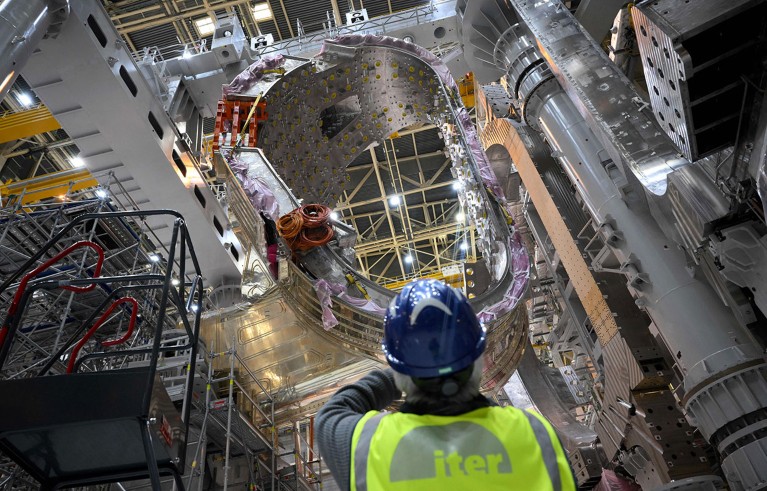Hello Nature readers, would you like to get this Briefing in your inbox free every day? Sign up here.
A module being assembled at the international nuclear fusion project ITER in Saint-Paul-lez-Durance in southern France.Credit: Nicolas Tucat/AFP via Getty
ITER might be beaten to fusion goal
The world’s biggest fusion-energy experiment, ITER, likely won’t be the first facility of its kind to hit a major milestone: creating more energy from a fusion reaction than is directly put into it. ITER’s major experiments have been pushed back by four years, to 2039, at a cost of more than US$5 billion. But physicists say that the project remains essential to building the foundations of a future fusion industry. “ITER is still going to be extremely relevant and extremely important, no matter when it comes,” says plasma physicist Rachael McDermott.
Nature | 7 min read
How to beat ‘superhuman’ AI
KataGo, a Go-playing AI system that can beat the world’s best human players, can be defeated by adversarial bots. These bots aren’t themselves good at the game — even amateurs can beat them — but they excel at feeding KataGo with inputs that cause it to make mistakes. Strategies for fortifying KataGo against such adversarial attacks mostly failed. “If we can’t solve the issue in a simple domain like Go, then in the near-term there seems little prospect of patching similar issues like jailbreaks in ChatGPT,” says AI researcher and study co-author Adam Gleave.
Nature | 5 min read
Reference: arXiv preprint (not peer reviewed)
Zircons rewrite history of plate tectonics
The tectonic activity that forms our favourite planetary pointy bits might have begun something like 700 million years earlier than other evidence suggests. Geophysicists looked at ‘S-type’ zircons from Western Australia — the only material that survives from the Hadean Era, more than 4 billion years ago. They contain inclusions that could be evidence of continents and subduction — and thus the existence of plate tectonics — at the time they were formed, say researchers.
Science | 5 min read
Reference: Proceedings of the National Academy of Sciences paper
Features & opinion
How to fight science’s mental-health crisis
Universities and institutions across the globe are finding ways of helping students and staff cope with the stress of academic life. Courses on mindfulness and mental health can help scientists — who often see their career as a calling — separate failures at work from their self-worth. Career workshops can target job insecurity, a key stressor for many academics. Critics argue that mental-health efforts won’t help scientists to win a grant or receive tenure. Others feel that the focus on individuals is needed to drive systemic changes. “My sense is that if I can empower the individual, then that individual can also push back,” says clinical psychologist Desiree Dickerson.
Nature | 9 min read
The seed of a thousand conspiracies
A new book by historian Joshua Blu Buhs is damning about the cultural role of Forteans — the granddaddy of anti-science movements. They pursue a mysticism-infused scepticism towards science that was inspired by Charles Fort (1874–1932), who dedicated his career to gathering accounts of unexplained anomalies. “They eroded the distinctions between truth and falsity, undermined the authority of experts and expertise,” writes Blu Buhs. “They launched a thousand conspiracies into the national consciousness.”
Nature | 6 min read
Faecal transplants are a ‘stepping stone’
Researchers have taken great strides towards using faecal microbiota transplants (FMTs) to improve people’s response to immunotherapy. “We have now patients that are still alive, cancer free, four years after the first trial,” says oncologist Bertrand Routy. However, the composition of microbes in the gut differs from donor to donor, meaning that faecal transplants cannot be standardized and are hard to commercialize. “FMT is a stepping stone,” says cancer researcher Jennifer Wargo. The next phase will be to create uniform packages of known bacteria, or to replicate the effects of bacteria using drugs.
Nature | 12 min read
This article is part of Nature Outlook: The human microbiome, an editorially independent supplement produced with financial support from Yakult.
Where I work: Africa

Viticulture researcher Erna Blancquaert (right, with MSc student Sindiswa Zandile) starts work at dawn in the vineyards of South Africa’s celebrated Stellenbosch wine region. This time of day, before plant metabolism starts and the heat of the day sets in, is best for measuring the water status of grapevines and sampling fruit when its flavour is at its peak. Blancquaert and her team study the impact of sustainable and regenerative viticulture practices, such as using seaweed as a fertilizer and allowing cattle to graze in vineyards. (Nature Africa | 3 min read — aussi en français)
See more of the Where I Work series from Nature Africa.
